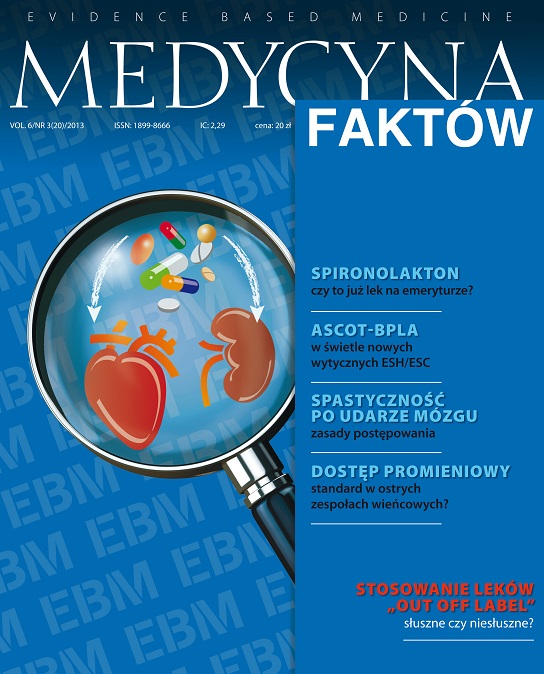Stroke-related spasticity Review article
Main Article Content
Abstract
The paper discusses various aspects of the treatment of spasticity after stroke. Post-stroke spasticity is a significant clinical problem, due to the possibility of a significant reduction in activities of daily living (ADL), as well as the potential to contribute to the development of complications. The basic component of effective treatments for post-stroke spasticity is the correct estimates and monitoring, mostly with the use of scale MAS. One of the available treatment options, particularly the extensive spasticity, is the administration of tolperisone, muscle tension lowering agent for multi-level action. This report addresses key clinical trial (Stamenova 2005), which demonstrated high efficacy and safety of treatment of spasticity after impact tolperizone.
Article Details
Copyright © by Medical Education. All rights reserved.
References
2. Watkins C.L., Leathley M.J., Gregson J.M., Moore A.P., Smith T.L., Sharma A.K.: Prevalence of spasticity post stroke. Clin. Rehabil. 2002; 16: 515-22.
3. O’Brien C.F., Seeberger L.C., Smith D.B.: Spasticity after stroke. Epidemiology and optimal treatment. Drugs Aging 1996; 9(5): 332-40.
4. Lance J.W.: What is spasticity? Lancet 1990; 335: 606.
5. Cooper A., Musa I.M., van Deursen R., Wiles C.M.: Electromyography characterization of stretch responses in hemiparetic stroke patients and their relationship with the Modified Ashworth scale. Clin. Rehabil. 2005; 19: 760-6.
6. Kim D.Y., Park C.I., Chon J.S., Ohn S.H., Park T.H., Bang I.K.: Biomechanical assessment with electromyography of post-stroke ankle plantar flexor spasticity. Yonsei Med. J. 2005; 46: 546-54.
7. Welmer A.K., von Arbin M., Widen Holmqvist L., Sommerfeld D.K.: Spasticity and its association with functioning and health-related quality of life 18 months after stroke. Cerebrovasc. Dis. 2006; 21: 247-53.
8. Thompson F.J., Parmer R., Reier P.J., Wang D.C., Bose P.: Scientific basis of spasticity: insights from a laboratory model. J. Child. Neurol. 2001; 16: 2-9.
9. Mayer N.H.: Clinicophysiologic concepts of spasticity and motor dysfunction in adults with an upper motoneuron lesion. Muscle Nerve Suppl. 1997; 6: S1-13.
10. Pierson S.H.: Outcome measures in spasticity management. Muscle Nerve Suppl. 1997; 6: S36-60.
11. Hsieh Y.W., Hsueh I.P., Chou Y.T., Sheu C.F., Hsieh C.L., Kwakkel G.: Development and validation of a short form of the Fugl-Meyer motor scale in patients with stroke. Stroke 2007; 38: 3052-4.
12. van der Salm A., Veltink P.H., Hermens H.J., Ijzerman M.J., Nene A.V.: Development of a new method for objective assessment of spasticity using full range passive movements. Arch. Phys. Med. Rehabil. 2005; 86: 1991-7.
13. Lockley L.: The role of the specialist physiotherapist in the management of spasticity. Way Ahead 2004; 7: 6-7.
14. Katz R.T., Rovai G.P., Brait C. et al.: Objective quantification of spastic hypertonia: correlation with clinical findings. Arch. Phys. Med. Rehabil. 1992; 73(4): 339-47.
15. Goldstein E.M.: Spasticity management: an overview. J. Child. Neurol. 2001; 16: 16-23.
16. Tilton A.H.: Injectable neuromuscular blockade in the treatment of spasticity and movement disorders. J. Child. Neurol. 2003; 18(Suppl. 1): S50-66.
17. Van Kuijk A.A., Geurts A.C.H., Bevaart B.J.W., van Limbeek J.: Treatment of upper extremity spasticity in stroke patients by focal neuronal or neuromuscular blockade: a systematic review of the literature. J. Rehab. Med. 2002; 34: 51.
18. Mc Guire J.R.: Effective use of chemodenervation and chemical neurolysis in the management of poststroke spasticity. Top. Stroke Rehabil. 2001; 8: 47.
19. Gracies J.M., Nance P., Elovic E. et al.: Traditional pharmacological treatments for spasticity. Part II: General and regional treatments. Muscle Nerve Suppl. 1997; 6: S92-120.
20. Gracies J.M., Elovic E., McGuire J. et al.: Traditional pharmacological treatments for spasticity. Part I: Local treatments. Muscle Nerve Suppl. 1997; 6: S61-91.
21. Pratzel H.G., Alken R.G., Ramm S.: Efficacy and tolerance of repeated oral doses of tolperisone hydrochloride in the treatment of painful reflex muscle spasm: results of a prospective placebo-controlled double-blind trial. Pain 1996; 67(2-3): 417-25.
22. Stamenova P., Koytchev R., Kuhn K. et al.: A randomized, double-blind, placebo-controlled study of the efficacy and safety of tolperisone in spasticity following cerebral stroke. Eur. J. Neurol. 2005; 12(6): 453-61.

